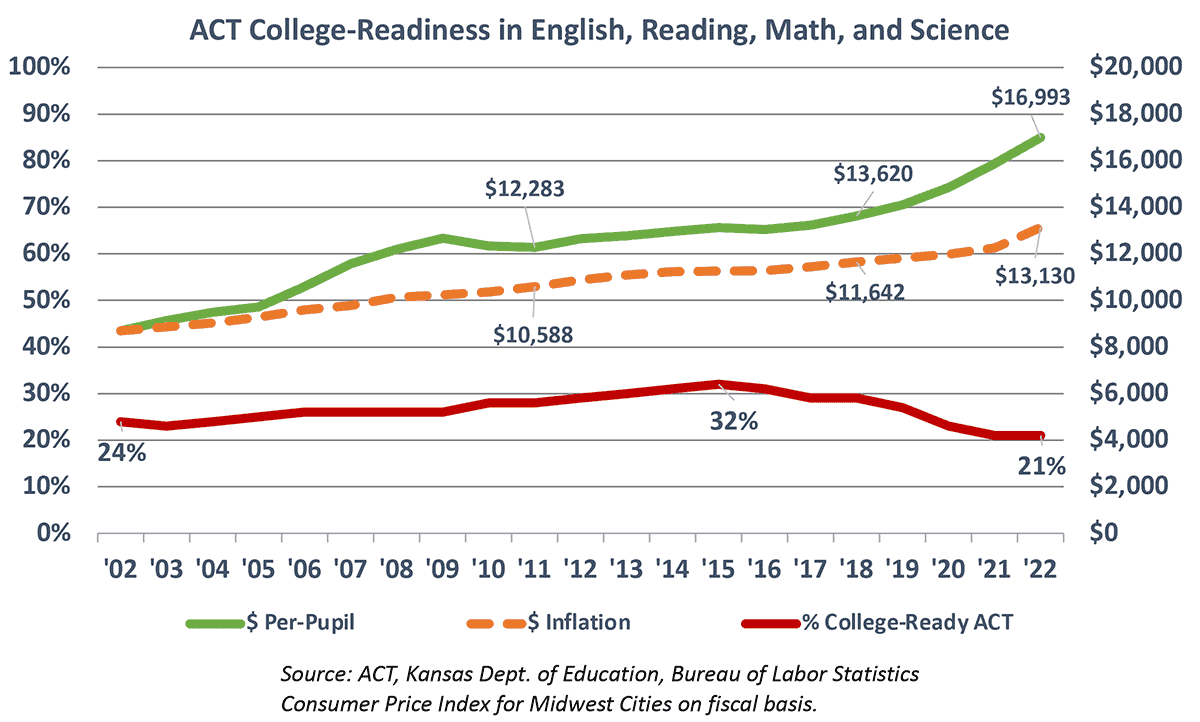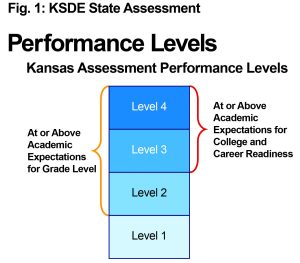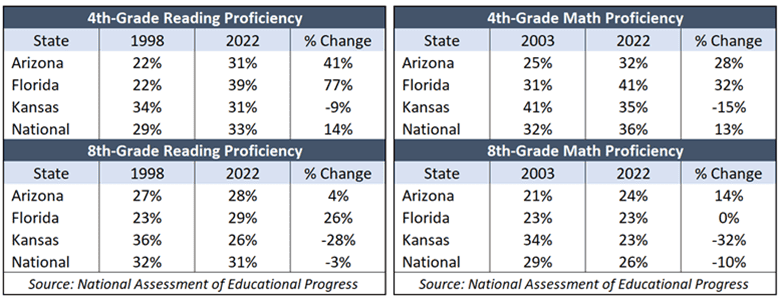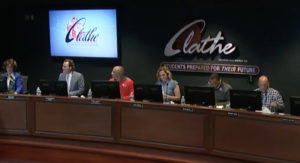Recommendations to improve achievement by changing adult behaviors
(The Sentinel) – Testimony submitted this week to the Kansas Special Committee on Education crystalized three unfortunate realities:
(1) student achievement is low and has been trending down…

(The Sentinel) – Testimony submitted this week to the Kansas Special Committee on Education crystalized three unfortunate realities:
(1) student achievement is low and has been trending down for many years, with significant achievement gaps for low-income students; (2) achievement will remain persistently low until adult behaviors change in the education bureaucracy, and (3) most education officials have no intention of changing their behavior.
I’m not talking about teachers and others who work in the trenches. This reality concerns officials at the Department of Education (KSDE), the State Board of Education, the Kansas Association of School Boards (KASB), the teacher unions, many superintendents, and other administrators. They claim to want student achievement to improve but won’t change their behaviors to make it happen.
The hearings examined Kansas’s education climate and its impact on student achievement. Aside from Kansas Legislative Research, the Division of Post Audit, and the Office of the Revisor of Statutes, testimony generally fell into two buckets. The bureaucracy attempted to justify continuing the efforts that produced low achievement and witnesses who proposed changes to improve outcomes.
Bureaucrats tried to excuse away years of bad results. For example, KASB proclaimed Kansas is one of just six states that didn’t experience declines in ACT scores in 2022. The reality is that the 2022 results were the same as those from 2021, which were the worst scores recorded in more than 30 years. Only 21% of Kansas graduates were college-ready in English, Reading, Math, and Science. KASB tried to pitch that as ‘good news.’

KSDE said the state assessment doesn’t identify students below grade level because it only measures grade-level competencies. Trying to say that students who perform poorly on grade-level-appropriate reading and math measures insults the intelligence of parents who trust their kids to public schools.

They acknowledge that about a third of students have limited ability to perform at grade level, which obviously means those kids are not performing at grade level. But KSDE doesn’t like the ‘below grade level’ label because it sounds bad (which it is), so it scrubbed ‘grade level’ from the description for the sake of appearance. Originally, Level 1 was clearly ‘below grade level’ because Levels 2-4 were identified as ‘at or above grade level.’
Even the Kansas Supreme Court wrote, “Level one is students who are not performing at grade level in the given subject.”[i]
The Division of Post Audit recapped findings from its 2023 examination on the use of “at-risk” funding that are about the same as its 2019 audit – school districts still are not spending money on “above and beyond” services as required by state law. The State Board of Education took no action following the 2019 audit, and KSDE’s testimony made it apparent that legal violations would continue.
School districts and the bureaucracy are also ignoring the building needs assessment law. It says, “school boards shall conduct” annual assessments of each school to identify barriers to students reaching proficiency and the budgetary changes required to overcome them. Evidence showing school districts have failed to comply with the law each of the last three years was given to the committee. This included the fact that superintendents will not allow board members to participate in meetings with teachers and principals. The records were obtained by Kansas Policy Institute, owner of The Sentinel, via Open Records requests.
Several organizations were asked to provide recommendations to improve state assessment results, which show Kansas has more students below grade level than are proficient. Common sense dictates that doing the same things over and over again will not suddenly reverse the trend, but that is what the bureaucracy proposed – more of the same with more money on top.
Ideas to improve student achievement
Several organizations offered ideas that buck the status quo, and most of them focused on changing adult behaviors.
- Build character. Troy Pitsch, Superintendent of USD 329 Wabaunsee, discussed remarkable student achievement gains since the district embraced the Franklin Covey “Leader in Me” curriculum. The Kansas Department of Education requires social-emotional learning to be accredited, and Wabaunsee fulfills that mandate by teaching leadership and building character.
- Embrace the science of reading. David Hurford, Director of the Center for READing at Pittsburg State University, says there is only one effective way to teach kids how to read, yet there are many teachers in Kansas and across the country who are not trained in the science of reading. School boards should ensure that all teachers have the training and use it in the classroom.
- Require districts to publish state assessment results on the front page of their websites. The report should include historical trends for all students, low-income students, and students who are not low-income. Current year results for each grade tested (3-8 and 10) should also be provided.
- Accreditation should be based primarily on academic improvement. Currently, districts are not required to show academic improvement to be accredited. Indeed, much of the accreditation model involves paperwork and documentation at the district level rather than each school.
- Build on the Legislature’s literacy efforts by making university funding contingent on teaching the science of reading. Wichita State University, Fort Hays State University, and the University of Kansas get good marks from the National Council on Teacher Quality. Pittsburg State receives an F, and Emporia State and Kansas State University (so far) refuse to provide reading course syllabi to conduct an analysis.
- Expand school choice, which has improved public school achievement in states with robust options. The 2023 edition of The 123s of School Choice examined the findings of 29 research studies of the impacts of choice on public school students test scores; 26 studies (90%) found positive effects, one (3%) found no effect, and two (7%) found a negative effect. Competition encourages public schools to work harder to retain students, which is reflected in NAEP scores for the states with long-established and robust choice options – Florida and Arizona. Reading and math proficiency gains for Arizona and Florida are much greater than the national average. While those states improved, Kansas declined significantly despite spending a lot more per student.

Dr. Patrick Wolfe, Distinguished Professor of Educational Policy at the University of Arkansas, presented additional research showing that school choice has an overwhelmingly positive impact on student achievement in public and private settings. He also cited studies showing the societal benefits of choice, including political tolerance, political participation, civic knowledge and skills, and volunteerism.
- Accreditation should be tied to full compliance with the building needs assessment. Districts should be required to notify parents in writing if the accreditation status changes for not following state law.
- Students in districts that do not follow state laws on at-risk spending or building needs assessments should be eligible for education savings accounts. Both laws are designed to improve outcomes, so students should be allowed to go elsewhere if district officials ignore those laws.
- Modify achievement targets in the building needs assessment law. Proficiency should align with the Department of Education’s 75% target, and another target should focus on moving students out of Level 1 (Below Grade Level).
- Require written documentation of the budgetary changes made (dollar amounts allocated to overcome barriers and the source of the money) on each building needs assessment.
- Require school boards to document the amount of time spent at each board meeting reviewing efforts to improve student achievement in board meeting minutes. Most school boards spend less than 5% of the time at board meetings reviewing efforts to improve outcomes.
The education bureaucracy is forcing legislators to choose to intervene with these student-focused efforts to compel change in adult behaviors or accept having a third of students below grade level as the new norm.



